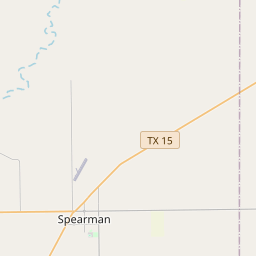Lindberghs Land at Spearman
Historical marker location:






At ten minutes before 11:00 a.m. on Monday, September 24, 1934, a small monocoupe airplane landed in a pasture about 1/4 mile west of this site. The pilot taxied his craft to a stop near a windmill, deplaned, and asked the curious resident, "Lady, can I park my plane in your back yard?"
The day proved a momentous one for Spearman residents. The pilot was Charles Augustus Lindbergh (1902-1974), traveling from California to New York with his wife, Anne. With about one hundred miles worth of fuel left in his plane, Lindbergh chose to stop in this small community to refuel in oder to avoid the inevitable crowds his arrival would cause in a larger town. A passing motorist was sent into town to purchase fuel for the airplane while the Lindberghs rested, enjoyed refreshments, and gave their hostess a tour of the airplane.
As news of the Lindberghs' landing spread, school children were excused from classes to see the famous aviator and watch the plane depart two hours later. Although brief in duration, the visit by Charles and Anne Morrow Lindbergh to this small rural community was a significant local event. (1989)
As one of the most visible programs of the Texas Historical Commission (THC), historical markers commemorate diverse topics in Texas history, including: the history and architecture of houses, commercial and public buildings, religious congregations, and military sites; events that changed the course of local and state history; and individuals who have made lasting contributions to the state, community organizations, and businesses.
Texas is also home to the world's largest honky-tonk, Billy Bob's Texas in Fort Worth. The venue covers three acres and can hold up to 6,000 people.
In the 1870s, Hansford County experienced its first wave of settlement as ranchers and farmers began to establish homesteads in the area. The arrival of the railroad in 1887 further spurred growth and development, as it provided a vital link for transporting goods and people. The county was officially organized in 1889 and named after John M. Hansford, a Texas congressman who was known for his support of the Texas Panhandle region.
The early settlers faced numerous challenges, including droughts, harsh weather conditions, and conflicts with Native American tribes. However, their perseverance paid off, and the county's agriculture and ranching industries began to thrive. Wheat, corn, and cotton became important crops, while cattle ranching became a prominent livelihood for many residents.
In the 20th century, Hansford County continued to evolve with advancements in technology and infrastructure. The discovery of oil in the 1920s brought a new wave of economic growth and prosperity to the area. Today, Hansford County is a thriving community that celebrates its western heritage and rich agricultural traditions while embracing modern industries and opportunities for growth.
Hansford County Timeline
This timeline provides a concise overview of the key events in the history of Hansford County, Texas.
- 1876 - Hansford County is created and named after John M. Hansford, a Texas state congressman.
- 1880 - The first settlers begin arriving in the area, attracted by the availability of land for farming and ranching.
- 1886 - Hansford becomes an organized county with the establishment of county government.
- 1891 - The town of Hansford is established as the county seat.
- 1900 - The county's population reaches around 3,000, primarily engaged in agriculture and livestock raising.
- 1910 - The discovery of oil leads to an economic boom in the county.
- 1929 - The Great Depression hits Hansford County hard, resulting in economic hardships for the residents.
- 1950s - The discovery of natural gas reserves provides a boost to the county's economy.
- 1960s - The construction of Lake Marvin, a recreational reservoir, attracts tourists to the area.
- 1980s - The agriculture and energy sectors continue to dominate the county's economy.